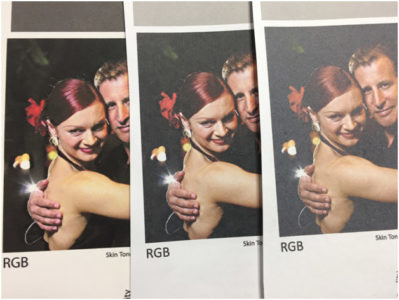Shift Happens: Understanding Aqueous Ink Chemistry

Inkjet ink chemistry can vary by device and process. Many inks have been developed to be compatible with specific substrate conditions. Knowing the type of ink and understanding its chemistry is just as important as understanding how it reacts to your surface conditions.
Aqueous, ultra violet (UV) and solvent are the three most common chemistries today. For the high speed and industrial print markets, aqueous and UV are most commonly used.
Aqueous Ink and Colorant Differences
Aqueous is just what its name entails; aqua or water. Water is the highest percentage within the chemistry of this type of ink and is used as a carrier to deliver the inks colorant within a drop. Used in high speed inkjet, wide format, as well as textile printing, aqueous ink gets its color from either dye or pigment.
Dye colorants are organic and have brighter undertones and higher transparency than pigment. Dye requires substrates with an ink receptive coating to allow the colorant to quickly bind while the water content evaporates. Dye is a soluble colorant which works well on specialized inkjet coated papers such as the ones used on desktop and wide format printers but does not deliver the same high-end results on high speed inkjet devices. On porous (uncoated) media, since the ink and the dyes are soluble, dye ink will absorb quickly into the surface leaving printed graphics washed out. This is less of an issue when used with inkjet coated or primed media.

Inkjet Coated Primed Uncoated
To address the varied image performance and light and water fastness with dye, OEMs began moving to aqueous pigment to increase the performance characteristics. Pigment colorant, unlike dye, is insoluble. The colored pigment particles separate quickly from the aqueous carrier. However, like dye, pigment colorants respond best to absorbent coatings on non-porous media and primed porous media. These surfaces trap the pigment flake on, or closer to, the surface creating higher chroma (remember chroma represents a color’s purity).Drying
Aqueous inks require heat or convection air flow to assist with the evaporation of the carrier (water). In some cases infra-red is also added to remove the abundance of humidity which is created when printing high coverage on low porous materials, help dry the ink faster and maintain production speeds . Cases of high humidity have been known to create a misting or even rain within the inkjet device. Drying is a crucial of part of working with aqueous inkjet because water must be properly extracted from the ink at high speeds.

Dye vs. Pigment Costs
Dye inks are less expensive to manufacture than pigment inks. Remember those pigment particles mentioned earlier? Stabilizing a pigment formula for inkjet ink is no easy task. Developing inorganic pigment ink depends on five variables in order to achieve color intensity, gloss and opacity.
- Proper disbursement
- Surface energy
- Dwell time
- Print head
- Pigment interactions
Shift Happens with Aqueous Inks
Both types of aqueous inks are highly coating/primer and substrate dependent. If a substrate has coating applied at the manufacturer or primers applied inline of the process, the chemistry, volume and drying aspects of aqueous inks will vary. For all substrates; coated, porous or non-porous, each ink color can react differently, creating varied absorption, dot spread, ink limiting and drying requirements.
You may also notice that aqueous pigment inks used on different devices produce different color values or gamut size on the same medium. Maybe one device prints deeper reds than another. The color gamut, which can be reproduced with a pigment ink, is dependent on the size of the pigment particles themselves. The size directly affects achievable color and the jetting accuracy of a print head. Pigment particle sizes are determined on the target viscosity of the ink chemistry itself. Jet speeds and drop size greatly affect particle sizes used.
When considering aqueous inks, keep in mind that there are many factors which can affect color regardless of pigment or dye. The key is separating the colorant quickly from the water, keeping printed colors pure and smooth without any mottle or coalescence by choosing the right surface to print on.
Inkjet Insight offers inkjet training as well as ink-to-substrate evaluation, print quality and custom primary ink limiting for high speed production, industrial inkjet manufacturers or end users who may need assistance with print quality or color. Contact Mary Schilling @ [email protected] for more information

